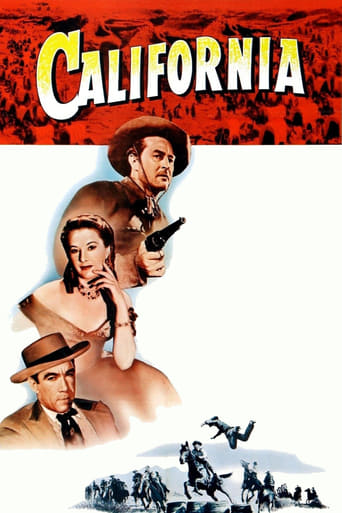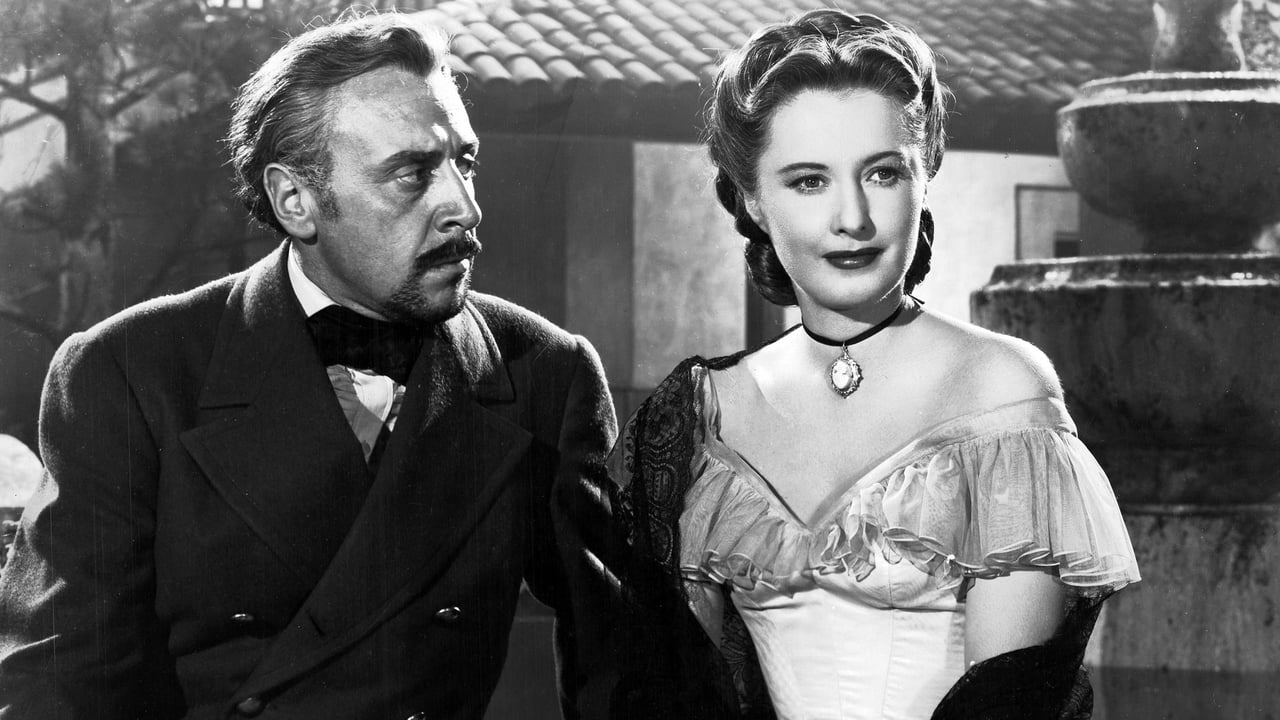JohnHowardReid
Director: John Farrow. Producer: Seton I. Miller. Copyright 21 February 1947 by Paramount Pictures Inc. New York opening at the Rivoli: 14 January 1947. U.S. release: 21 February 1947. U.K. release: 14 April 1947. Australian release: oddly no official release date despite the fact that this was one of Paramount's prestige releases of the year. Sydney opening at the Prince Edward: 18 April 1947 (ran four weeks). 8,758 feet. 97 minutes.SYNOPSIS: A former slave trader's plans to make California his own empire are thwarted by a moralistic army-deserter and an idealistic grape-grower.NOTES: Stanwyck's first color film. Filmed on locations (including Sedona) in Arizona.COMMENT: Much admired by many critics, including my colleague Barrie Pattison who swears that California is "one of the supreme achievements of mankind". I am of a lesser opinion. True, Farrow's direction is wonderfully fluid, with at least four or five extremely long, extremely elaborate and complicated one-takes. But their dramatic impact is often dissipated by a faulty script which lets Farrow down on a number of fronts: Firstly, the narrative construction is oddly episodic, with various segments separated by surrealistic chorales. Now I'm all in favor of experimentation in the cinema, but it doesn't gel here. All this extolling the virtues of California by an off-camera chorus ("Get my bible and banjo... It's California, or bust!"), doesn't always sit too well with a petty tale of a gambling hussy on the wagon train. (Of course not all the singing is done off-camera. The wagon folks themselves render "I Should Have Stood in Massachusetts", while saloon singer Stanwyck — wearing gorgeous gowns — is expertly dubbed for "Lily-I-Lily-I-Oh" and the haunting ballad, "Said I To My Heart, Said I"). The second problem with the script is that, despite its length, characterization is so sketchy, it's hard to get involved with the principals. Milland doesn't help much. Acquits himself well enough in the action spots, true, but otherwise just glumly rattles off his lines. Stanwyck plays with more fire in her spirit, and looks mighty fetching in Technicolor, but the script gives her such threadbare cloth to fashion, it's no surprise her performance makes little impression. Ditto Barry Fitzgerald. The one player who does come across strongly is George Coulouris who makes his Captain Coffin not only truly menacing, but even truly human. Yet even here the script tries to undermine the character (what a pity the haunting of naked feet pattering across the deck is only alluded to but once). Fortunately, such is Coulouris' skill he manages to force our interest interest upon the captain right through to his anticipated end. The other villains are distinctly minor by comparison, but Dekker and Muir manage them ably.The script's third vice is its overly verbose dialogue. Practically all of Fitzgerald's part could go with no loss of interest or continuity, and the scissors could likewise be taken to some of the principals' exchanges, plus three or four small but unnecessary scenes. Alas, in the print under review, Rennahan's once-lustrous color photography is now somewhat less than satisfying. Some superb images remain, however. The panning shot of all the furniture thrown from the wagons to facilitate the gold rush, for example. A flawed film, but still vastly entertaining. Superb sets, and unstintingly lavish production values help.
dougdoepke
The movie is a stab at an epic western that simply fails to gel. The best part is the "moving west" scenes of wagon trains convoying across the open southwestern terrain. These achieve an epic feel that the dramatics unfortunately fail to duplicate. The screenplay itself is pretty crowded, telling the story of California's becoming a state, no less. From settlers to gold rush to saloons to political intrigue, the story is traced out mainly through Milland, Stanwyck, and Coulouris, with Fitzgerald as a salt-of-the-earth anchor.Now, that might work, except director Farrow has little feel for the material. The various parts come across in rather limp, unexciting fashion. It's as if he's content to simply film the script without bringing its many conflicts to dramatic life. Thus, the drama is conveyed in words instead of characters. Then too, Oscar winner Milland appears either miscast or uninspired. His role really calls for a bigger personality than Milland's generally low-key wagon master. (He may have viewed a western as a comedown after his award winning role in The Lost Weekend.) Stanwyck is of course Stanwyck even though she's dolled-up to suit Technicolor filming and crowded around by the packed screenplay . Too bad the guy who could have enlivened the action remains in supporting background, namely, the commanding Albert Dekker (Pike).Anyway, I guess I now know why this epic western remains so obscure, despite its Paramount pedigree and marquee cast.
bkoganbing
If back in 1946 when California the movie was made, let alone in the 1840s when California came to the USA via the Mexican Cession, people knew what a sprawling entity California would become, the idea of a separate California country that George Coulouris wanted to have might have been the idea might have been sold. As it is now California has about 9% of the House of Representatives and a population and budget bigger than most countries.But we're back in the year of 1849 when trail guide Ray Milland is guiding a wagon train to the Pacific, to the newly acquired lands of the Mexican War. He's reluctantly allowed Barbara Stanwyck to travel with Barry Fitzgerald on the train. Stanwyck's been given a heave-ho out of town similar to what Claire Trevor got in Stagecoach. The two of them are mighty attracted to each other, but Milland thinks she's cheap and Stanwyck thinks he's stuck up.It tears it for Milland when Stanwyck upon reaching California takes up with George Coulouris, a powerful, rich, and mysterious former sea captain who gained his fortune in the slave trade. He's a mean one to cross and his ambitions include nothing less than carving out a separate California Empire with himself as head.So the political mixes with the personal as Milland fights Coulouris for California and Stanwyck.California was a big budget item for Paramount that year, the only thing it lacked was Cecil B. DeMille directing it. The film was shot on location in Sedona, Arizona in gorgeous technicolor, courtesy of Ray Rennahan. You have to remember that Milland had won the Best Actor Oscar for The Lost Weekend the previous year and Paramount was now trying to take advantage of that.Stanwyck loved making westerns and it sure shows here. This was Ray Milland's first starring western, he'd do a few more and not bad ones either. Fitzgerald steals the show of course in every scene he's in as the wise grape grower who sees vineyards in the Napa Valley as part of California's future.The whole thing is nicely directed by John Farrow. And of course Coulouris will creep you out with his brand of villainy. Catch it when it's broadcast.
dianefhlbsch
Definitely NOT a great movie, but very enjoyable, especially if one is a Stanwyck fan. Cinematography bounced back and forth from lush, to "quick, get it done" shots.Ray Milland did not quite cut it as the hardened trail boss and buffalo hunter. But maybe that's because his character really is not-he deserted from the army for getting involved with a married woman. Stanwyck shines as the self-reliant lady gambler and flirt who has been tossed around her whole life, with a few exceptions.Yes the movie is rather corny, but let's face it the movie industry was right in the middle of the Macarthy era and needed safe material to work with. It DID give a rather honest perspective of how many lost sight of what they really had set out for, and how others took advantage, at any cost.


 AD
AD



